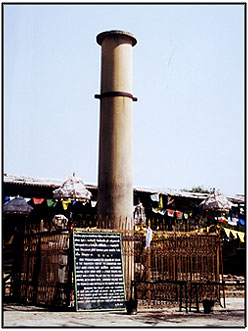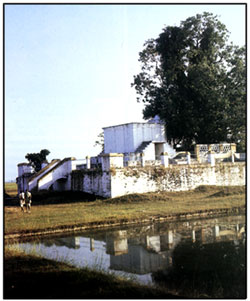Sama Gaon, Manaslu region Trekking, Nepal.
"An Exploration for Lifetime Experience"
"An Exploration for Lifetime Experience"

|
Lumbini
is the place where the Buddha, known as the Tathagata*
was born. It is the place which should be visited and
seen by a person of devotion and which should cause awareness
and apprehension of the nature of impermanence.' *
Tathagata - One who has found the Truth. The birthplace of the Gautama Buddha, Lumbini, is the Mecca of every Buddhist, being one of the four holy places of Buddhism. It is said in the Parinibbana Sutta that Buddha himself identified four places of future pilgrimage: the sites of his birth, enlightenment, first discourse, and death. All of these events happened outside in nature under trees. While there is not any particular significance in this, other than it perhaps explains why Buddhists have always respected the environment and natural law. |
|
|
Nativity
scene
|
| |
| |
 kyas
and Kolias clans. King Suddhodana, father of Gautama Buddha
was of the Shakya dynasty belonging to the Kshatriya or the
warrior caste. Maya Devi, his mother, gave birth to the child
on her way to her parent's home in Devadaha while taking rest
in Lumbini under a sal tree in the month of May in the year
642 B.C. The beauty of Lumbini is described in Pali and Sanskrit
literature. Maya Devi it is said was spellbound to see the natural
grandeur of Lumbini. While she was standing, she felt labor
pains and catching hold of a drooping branch of a Sal tree,
the baby, the future Buddha, was born.
kyas
and Kolias clans. King Suddhodana, father of Gautama Buddha
was of the Shakya dynasty belonging to the Kshatriya or the
warrior caste. Maya Devi, his mother, gave birth to the child
on her way to her parent's home in Devadaha while taking rest
in Lumbini under a sal tree in the month of May in the year
642 B.C. The beauty of Lumbini is described in Pali and Sanskrit
literature. Maya Devi it is said was spellbound to see the natural
grandeur of Lumbini. While she was standing, she felt labor
pains and catching hold of a drooping branch of a Sal tree,
the baby, the future Buddha, was born.  Lumbini
remained neglected for centuries. In 1895, Feuhrer, a famous German
archaeologist, discovered the great pillar while wandering about
the foothills of the Churia range. Further exploration and excavation
of the surrounding area revealed the existence of a brick temple
and a sandstone sculpture within the temple itself which depicts
the scenes of the Buddha's birth.
Lumbini
remained neglected for centuries. In 1895, Feuhrer, a famous German
archaeologist, discovered the great pillar while wandering about
the foothills of the Churia range. Further exploration and excavation
of the surrounding area revealed the existence of a brick temple
and a sandstone sculpture within the temple itself which depicts
the scenes of the Buddha's birth. 


Nepal - Tiny, But Fully Packed with Nature!It is talking, please listen... |
 Rhododendron
|
 Orchids
|
 Flora
|
 Cordyceps sinensis Other Major Herbs and Medicinal Plants found in Nepal:
|
 Banyan Tree
|
 Peepul Tree
|
 Rhino
|
 Bengal Tigers 
|
 Cow |
